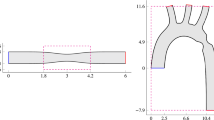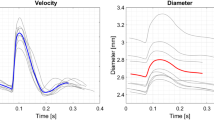Abstract
Arterial wall shear stress is hypothesized to be an important factor in the localization of atherosclerosis. Current methods to compute wall shear stress from magnetic resonance imaging (MRI) data do not account for flow profiles characteristic of pulsatile flow in noncircular vessel lumens. We describe a method to quantify wall shear stress in large blood vessels by differentiating velocity interpolation functions defined using cine phase-contrast MRI data on a band of elements in the neighborhood of the vessel wall. Validation was performed with software phantoms and an in vitro flow phantom. At an image resolution corresponding to in vivo imaging data of the human abdominal aorta, time-averaged, spatially averaged wall shear stress for steady and pulsatile flow were determined to be within 16% and 23% of the analytic solution, respectively. These errors were reduced to 5% and 8% with doubling in image resolution. For the pulsatile software phantom, the oscillation in shear stress was predicted to within 5%. The mean absolute error of circumferentially resolved shear stress for the nonaxisymmetric phantom decreased from 28% to 15% with a doubling in image resolution. The irregularly shaped phantom and in vitro investigation demonstrated convergence of the calculated values with increased image resolution. We quantified the shear stress at the supraceliac and infrarenal regions of a human abdominal aorta to be 3.4 and 2.3 dyn/cm2, respectively. © 2002 Biomedical Engineering Society.
PAC2002: 8761-c, 8719Uv
Similar content being viewed by others
REFERENCES
Berne, R. M., and M. N. Levy. Cardiovascular Physiology, 7th ed. St. Louis: Mosby Year Book, 1997, pp. 1-5.
Bernstein, M. A., et al. Concomitant gradient terms in phase contrast MR: Analysis and correction. Magn. Reson. Med. 39:300-308, 1998.
Caro, C. G., J. M. Fitz-Gerald, and R. C. Schroter. Atheroma and arterial wall shear: Observation, correlation and proposal of a shear dependent mass transfer mecahanism for atherogenesis. Proc. R. Soc. London, Ser. B 177:109-159, 1971.
Cornhill, J., E. Herderick, and H. Stary. Topography of human aortic sudanophilic lesions. In: Monographs in Atherosclerosis, edited by D. W. Liepsch. 1990, pp. 13-19.
Cybulsky, M. I., and M. A. Gimbrone, Jr. Endothelial expression of a mononuclear leukocyte adhesion molecule during atherogenesis. Science 251:788-791, 1991.
Davies, P. F. Flow-mediated endothelial mechanotransduction. Physiol. Rev. 75:519-560, 1995.
Fatemi, R. S., and S. E. Rittgers. Derivation of shear rates from near-wall lda measurements under steady and pulsatile flow conditions. J. Biomech. Eng. 116:347-368, 1994.
Friedman, M. H., G. M. Hutchins, and C. B. Bargeron. Correlation between intimal thickness and fluid shear in human arteries. Atherosclerosis 39:425, 1981.
He, X., and D. Ku. Pulsatile flow in the human left coronary artery bifurcation: Average conditions. J. Biomech. Eng. 118:74-82, 1996.
Hughes, T. The Finite Element Method. Englewood Cliffs, NJ: Prentice-Hall, 1987.
Ku, D., et al. Pulsatile flow and atherosclerosis in the human carotid bifurcation: Positive correlation between plaque location and low oscillating shear stress. Arteriosclerosis (Dallas) 5:293-302, 1985.
Loth, F. Velocity and wall shear stress measurements inside a vascular graft model under steady and pulsatile flow conditions. Georgia Institute of Technology, 1993.
Lou, Z., W. J. Yang, and P. D. Stein. Errors in the estimate of arterial wall shear rates that result from curve fitting of velocity profiles. J. Biomech. Eng. 26:383-390, 1993.
Masaryk, A. M., et al. In vitro and in vivo comparison of three MR measurement methods for calculating vascular shear stress in the internal carotid artery. Am. J. Neuroradio. 20:237-245, 1999.
Milner, J. S., et al. Hemodynamics of human carotid artery bifurcations: Computational studies with models reconstructed from magnetic resonance imaging of normal subject. J. Vasc. Surg. 28:143-156, 1998.
Nerem, R. M. Vascular fluid mechanics, the arterial wall, and atherosclerosis. J. Biomech. Eng. 114:274-282, 1992.
Osher, S., and J. A. Sethian. Fronts propagating with curvature-dependent speed: Algorithms based on Hamilton-Jacobi formulations. J. Comput. Phys. 79:12-49, 1998.
Oshinski, J. N., et al. Determination of wall shear stress in the aorta with the use of MR phase velocity mapping. J. Magn. Reson Imaging 5:640-647, 1995.
Oyre, S., et al. In vivo wall shear stress measured by magnetic resonance velocity mapping in the normal human abdominal aorta. Eur. J. Vasc. Endovasc Surg. 13:263-271, 1997.
Oyre, S., et al. Quantitation of circumferential subpixel vessel wall position and wall shear stress by multiple sectored three-dimensional paraboloid modeling of velocity encoded cine MR. Magn. Reson. Med. 40:645-655, 1998.
Pedersen, E. M., M. Agerbaek, I. B. Kristensen, and A. P. Yoganathan. Wall shear stress and early atherosclerotic lesions in the abdominal aorta in young adults. Eur. J. Vasc. Endovasc Surg. 13:443-451, 1997.
Pelc, N. J., et al. Phase contrast cine magnetic resonance imaging. Magn. Reson. Q. 7:229-254, 1991.
Perktold, K., et al. Pulsatile non-Newtonian flow in threedimensional carotid bifurcation models: Numerical study of flow phenomena under different bifurcation angles. J. Biomed. Eng. 13:507-515, 1991.
Perktold, K., and G. Rappitsch. Computer simulation of local blood flow and vessel mechanics in a compliant carotid artery bifurcation model. J. Biomech. 28:845-856, 1995.
Sawchuk, A. P., et al. Prospective, in vivo study of the relationship between blood flow hemodynamics and atherosclerosis in a hyperlipidemic swine model. J. Vasc. Surg. 19:58-64, 1994.
Sethian, J. A. Level Set Methods. Cambridge, U.K.: Cambridge University Press, 1996.
Taylor, C., T. Hughes, and C. Zarins. Computational investigations in vascular disease. Comput. Phys. 10:224-232, 1996.
Taylor, C. A., T. J. R. Hughes, and C. K. Zarins. Finite element modeling of three-dimensional pulsatile flow in the abdominal aorta: Relevance to atherosclerosis. Ann. Biomed. Eng. 26:1-14, 1998.
Wang, K., R. Dutton, and C. Taylor. Geometric image segmentation and image-based model construction for computational hemodynamics. IEEE Eng. Med. Biol. Mag. 18:33-39, 1999.
Wang, K. C. Level set methods for computational prototyping with application to hemodynamic modeling. In: Electrical Engineering. 2001, Stanford University: Stanford, CA: Stanford University, 2001.
Womersley, J. Method for the calculation of velocity, rate of flow and viscous drag in arteries when the pressure gradient is known. J. Physiol. (London) 127:553-563, 1955.
Zarins, C. K., et al. Carotid bifurcation atherosclerosis: Quantitative correlation of plaque localization with flow velocity profiles and wall shear stress. Circ. Res. 53:502-514, 1983.
Author information
Authors and Affiliations
Rights and permissions
About this article
Cite this article
Cheng, C.P., Parker, D. & Taylor, C.A. Quantification of Wall Shear Stress in Large Blood Vessels Using Lagrangian Interpolation Functions with Cine Phase-Contrast Magnetic Resonance Imaging. Annals of Biomedical Engineering 30, 1020–1032 (2002). https://doi.org/10.1114/1.1511239
Issue Date:
DOI: https://doi.org/10.1114/1.1511239




